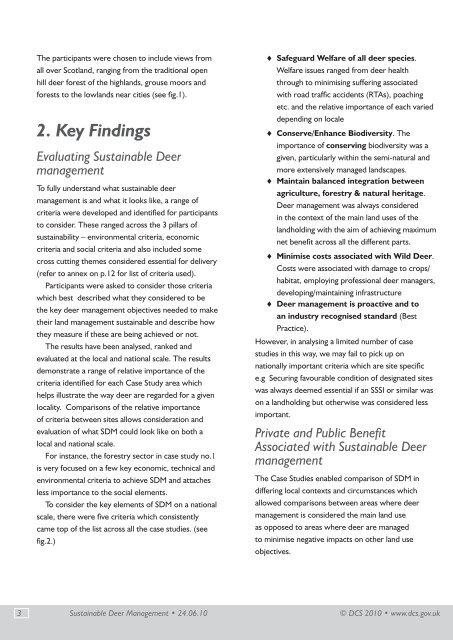Sustainable Deer Management A Case Study Report for the Deer ...
Sustainable Deer Management A Case Study Report for the Deer ...
Sustainable Deer Management A Case Study Report for the Deer ...
Create successful ePaper yourself
Turn your PDF publications into a flip-book with our unique Google optimized e-Paper software.
The participants were chosen to include views from<br />
all over Scotland, ranging from <strong>the</strong> traditional open<br />
hill deer <strong>for</strong>est of <strong>the</strong> highlands, grouse moors and<br />
<strong>for</strong>ests to <strong>the</strong> lowlands near cities (see fig.1).<br />
2. Key Findings<br />
Evaluating <strong>Sustainable</strong> <strong>Deer</strong><br />
management<br />
To fully understand what sustainable deer<br />
management is and what it looks like, a range of<br />
criteria were developed and identified <strong>for</strong> participants<br />
to consider. These ranged across <strong>the</strong> 3 pillars of<br />
sustainability – environmental criteria, economic<br />
criteria and social criteria and also included some<br />
cross cutting <strong>the</strong>mes considered essential <strong>for</strong> delivery<br />
(refer to annex on p.12 <strong>for</strong> list of criteria used).<br />
Participants were asked to consider those criteria<br />
which best described what <strong>the</strong>y considered to be<br />
<strong>the</strong> key deer management objectives needed to make<br />
<strong>the</strong>ir land management sustainable and describe how<br />
<strong>the</strong>y measure if <strong>the</strong>se are being achieved or not.<br />
The results have been analysed, ranked and<br />
evaluated at <strong>the</strong> local and national scale. The results<br />
demonstrate a range of relative importance of <strong>the</strong><br />
criteria identified <strong>for</strong> each <strong>Case</strong> <strong>Study</strong> area which<br />
helps illustrate <strong>the</strong> way deer are regarded <strong>for</strong> a given<br />
locality. Comparisons of <strong>the</strong> relative importance<br />
of criteria between sites allows consideration and<br />
evaluation of what SDM could look like on both a<br />
local and national scale.<br />
For instance, <strong>the</strong> <strong>for</strong>estry sector in case study no.1<br />
is very focused on a few key economic, technical and<br />
environmental criteria to achieve SDM and attaches<br />
less importance to <strong>the</strong> social elements.<br />
To consider <strong>the</strong> key elements of SDM on a national<br />
scale, <strong>the</strong>re were five criteria which consistently<br />
came top of <strong>the</strong> list across all <strong>the</strong> case studies. (see<br />
fig.2.)<br />
♦ ♦ Safeguard Welfare of all deer species.<br />
Welfare issues ranged from deer health<br />
through to minimising suffering associated<br />
with road traffic accidents (RTAs), poaching<br />
etc. and <strong>the</strong> relative importance of each varied<br />
depending on locale<br />
♦♦<br />
Conserve/Enhance Biodiversity. The<br />
importance of conserving biodiversity was a<br />
given, particularly within <strong>the</strong> semi-natural and<br />
more extensively managed landscapes.<br />
♦♦<br />
Maintain balanced integration between<br />
agriculture, <strong>for</strong>estry & natural heritage.<br />
<strong>Deer</strong> management was always considered<br />
in <strong>the</strong> context of <strong>the</strong> main land uses of <strong>the</strong><br />
landholding with <strong>the</strong> aim of achieving maximum<br />
net benefit across all <strong>the</strong> different parts.<br />
♦♦<br />
Minimise costs associated with Wild <strong>Deer</strong>.<br />
Costs were associated with damage to crops/<br />
habitat, employing professional deer managers,<br />
developing/maintaining infrastructure<br />
♦♦<br />
<strong>Deer</strong> management is proactive and to<br />
an industry recognised standard (Best<br />
Practice).<br />
However, in analysing a limited number of case<br />
studies in this way, we may fail to pick up on<br />
nationally important criteria which are site specific<br />
e.g Securing favourable condition of designated sites<br />
was always deemed essential if an SSSI or similar was<br />
on a landholding but o<strong>the</strong>rwise was considered less<br />
important.<br />
Private and Public Benefit<br />
Associated with <strong>Sustainable</strong> <strong>Deer</strong><br />
management<br />
The <strong>Case</strong> Studies enabled comparison of SDM in<br />
differing local contexts and circumstances which<br />
allowed comparisons between areas where deer<br />
management is considered <strong>the</strong> main land use<br />
as opposed to areas where deer are managed<br />
to minimise negative impacts on o<strong>the</strong>r land use<br />
objectives.<br />
3 <strong>Sustainable</strong> <strong>Deer</strong> <strong>Management</strong> • 24.06.10 © DCS 2010 • www.dcs.gov.uk
















